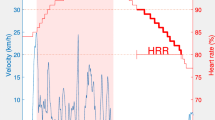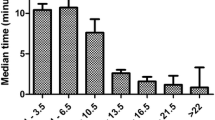Abstract
Purpose
The purpose of the study was to investigate a possible association between the distance covered in the Hoff test with parameters of maximal oxygen uptake (\( \dot{V}{\text{O}}_{{ 2 {\text{MAX}}}} \)), anaerobic threshold, anaerobic fitness, and body composition of professional adult soccer players.
Methods
Twenty-five professional soccer players (20 ± 3 years) participated in the study. On different days the athletes performed: a graded incremental exercise test in a laboratory to measure \( \dot{V}{\text{O}}_{{ 2 {\text{MAX}}}} \); a specific soccer field test called the Hoff test; a running anaerobic sprint test (RAST); an incremental test on an oval circuit to determine the velocity relative to anaerobic threshold (V AnT) and an estimation of body composition.
Results
The average \( \dot{V}{\text{O}}_{{ 2 {\text{MAX}}}} \) corresponded to 4.1 ± 0.1 L min−1 (54.1 ± 1.2 mL kg−1 min−1). The average distance covered during the Hoff test was 1,442.4 ± 30.0 m. The distance covered during the Hoff test showed significant correlations with absolute and expressed in an appropriated scale \( \dot{V}{\text{O}}_{{ 2 {\text{MAX}}}} \) (r = 0.44, p = 0.02; r = 0.42, p = 0.02, respectively) while no significant differences were found with body composition, V AnT and RAST variables.
Conclusions
The present study demonstrated that the distance covered during the Hoff test has weak correlation with \( \dot{V}{\text{O}}_{{ 2 {\text{MAX}}}} \) determined in treadmill running, and no correlation with V AnT, body composition and RAST outcomes, probably due to the non-specificity of the proposed tests when associated with the Hoff test.


Similar content being viewed by others
References
Reilly T (1996) Aspectos fisiológicos del fútbol. Actualización en Ciencias del Desporte 4:13
Bangsbo J (1994) Energy demands in competitive soccer. J Sports Sci 12:5–12
Helgerud J, Engen LC, Wisloff U, Hoff J (2001) Aerobic endurance training improves soccer performance. Med Sci Sports Exerc 33:1925–1931
Bishop D, Edge J, Goodman C (2004) Muscle buffer capacity and aerobic fitness are associated with repeated-sprint ability in women. Eur J App Physiol 92:540–547
McMillan K, Helgerud J, Grant SJ, Newell J, Wilson J, Macdonald R, Hoff J (2005) Lactate threshold responses to a season of professional British youth soccer. Br J Sports Med 39:432–436
Di Salvo V, Gregson W, Atkinson G, Tordoff P, Drust B (2009) Analysis of high intensity activity in premier league soccer. Int J Sports Med 30:205–212
Krustrup P, Mohr M, Amstrup T, Rysgaard T, Johansen J, Steensberg A, Pedersen PK, Bangsbo J (2003) The yo-yo intermittent recovery test: physiological response, reliability, and validity. Med Sci Sports Exerc 35:697–705
Bangsbo J, Iaia FM, Krustrup P (2007) Metabolic response and fatigue in soccer. Int J Sports Physiol Perform 2:111–127
Burgess DJ, Naughton G, Norton KI (2006) Profile of movement demands of national football players in Australia. J Sci Med Sport 9:334–341
Chamari K, Hachana Y, Kaouech F, Jeddi R, Moussa-Chamari I, Wisloff U (2005) Endurance training and testing with the ball in young elite soccer players. Br J Sports Med 39:24–28
Stolen T, Chamari K, Castagna C, Wisloff U (2005) Physiology of soccer: an update. Sports Med 35(6):501–536
Hoff J, Wisloff U, Engen LC, Kemi OJ, Helgerud J (2002) Soccer specific aerobic endurance training. Br J Sports Med 36:218–221
Kemi OJ, Hoff J, Engen LC, Helgerud J, Wisloff U (2003) Soccer specific testing of maximal oxygen uptake. J Sports Med Phys Fit 43:139–144
Nassis GP, Geladas ND, Soldatos Y, Sotiropoulos A, Bekris V, Souglis A (2010) Relationship between the 20-m multistage shuttle run test and 2 soccer-specific field tests for the assessment of aerobic fitness in adult semi-professional soccer players. J Strength Cond Res 24:2693–2697
Castagna C, Manzi V, Impellizzeri F, Weston M, Barbero Alvarez JC (2010) Relationship between endurance field tests and match performance in young soccer players. J Strength Cond Res 24:3227–3233
Zagatto AM, Miyagi WE, Sakugawa RL, Papoti M (2013) Use of maximal running distance performed on Hoff test for anaerobic threshold prediction in soccer. Rev Bras Med Esporte 19:267–270
Guedes DP, Guedes JERP (1998) Controle do peso corporal: Composição corporal. Atividade física e Nutrição, Shape, Londrina
Siri WE (1993) Body composition from fluid spaces and density: analysis of methods. 1961. Nutrition 9:480–491
Bentley DJ, Newell J, Bishop D (2007) Incremental exercise test design and analysis: implications for performance diagnostics in endurance athletes. Sports Med 37:575–586
Howley ET, Bassett DR, Welch HG (1995) Criteria for maximal oxygen uptake: review and commentary. Med Sci Sports Exerc 27:1292–1301
Wisloff U, Castagna C, Helgerud J, Jones R, Hoff J (2004) Strong correlation of maximal squat strength with sprint performance and vertical jump height in elite soccer players. Br J Sports Med 38:285–288
Hoff J (2005) Training and testing physical capacities for elite soccer players. J Sports Sci 23:573–582
Helgerud J, Hoydal K, Wang E, Karlsen T, Berg P, Bjerkaas M, Simonsen T, Helgesen C, Hjorth N, Bach R, Hoff J (2007) Aerobic high-intensity intervals improve VO2max more than moderate training. Med Sci Sports Exerc 39:665–671
Wong PL, Chamari K, Dellal A, Wisloff U (2009) Relationship between anthropometric and physiological characteristics in youth soccer players. J Strength Cond Res 23:1204–1210
Borg GA (1982) Psychophysical bases of perceived exertion. Med Sci Sports Exerc 14:377–381
Heck H, Mader A, Hess G, Mucke S, Muller R, Hollmann W (1985) Justification of the 4-mmol/l lactate threshold. Int J Sports Med 6:117–130
Zagatto AM, Beck WR, Gobatto CA (2009) Validity of the running anaerobic sprint test for assessing anaerobic power and predicting short-distance performances. J Strength Cond Res 23:1820–1827
Rowntree D (1991) Statistics without tears : a primer for non-mathematicians. Penguin Books, London
Loures JP, Chamari K, Ferreira EC, Campos EZ, Zagatto AM, Milioni F, Sanchez da Silva AR, Papoti M (2014) Specific determination of maximal lactate steady state in soccer players. J Strength Cond Res. doi:10.1519/JSC.0000000000000621
Lago-Penas C, Casais L, Dellal A, Rey E, Dominguez E (2011) Anthropometric and physiological characteristics of young soccer players according to their playing positions: relevance for competition success. J Strength Cond Res 25:3358–3367
Beck Zagatto AM, Gobatto CA (2014) Repeated sprint ability tests and intensity–time curvature constant to predict short-distance running performances. Sport Sci Health 2014(10):105–110
Conflict of interest
Alessandro Zagatto, Willian Miyagi, Gabriel Brisola, Fabio Milioni, Adelino da Silva, Paulo Santiago and Marcelo Papoti declare they have no conflicts of interest.
Author information
Authors and Affiliations
Corresponding author
Rights and permissions
About this article
Cite this article
Zagatto, A.M., Miyagi, W.E., Brisola, G.M.P. et al. Correlation between Hoff test performance, body composition and aerobic and anaerobic fitness in professional soccer players. Sport Sci Health 11, 73–79 (2015). https://doi.org/10.1007/s11332-014-0210-0
Received:
Accepted:
Published:
Issue Date:
DOI: https://doi.org/10.1007/s11332-014-0210-0




